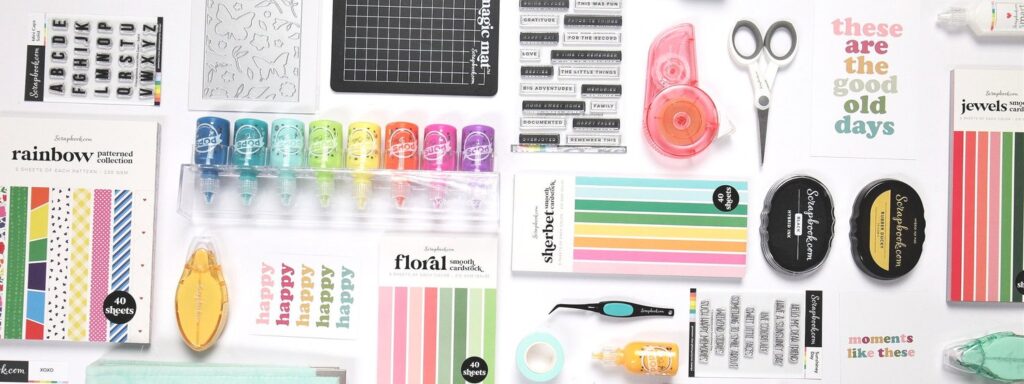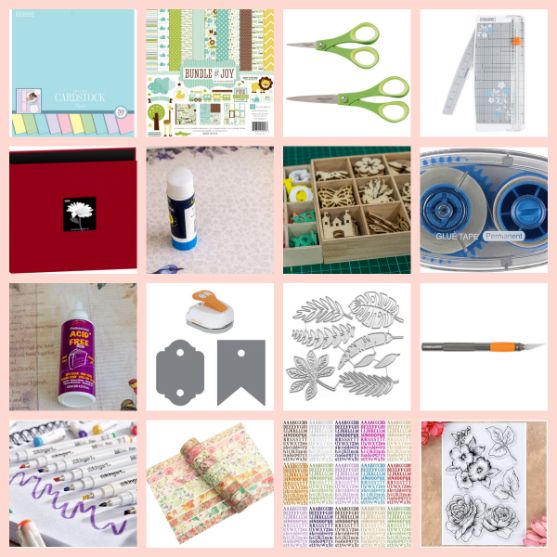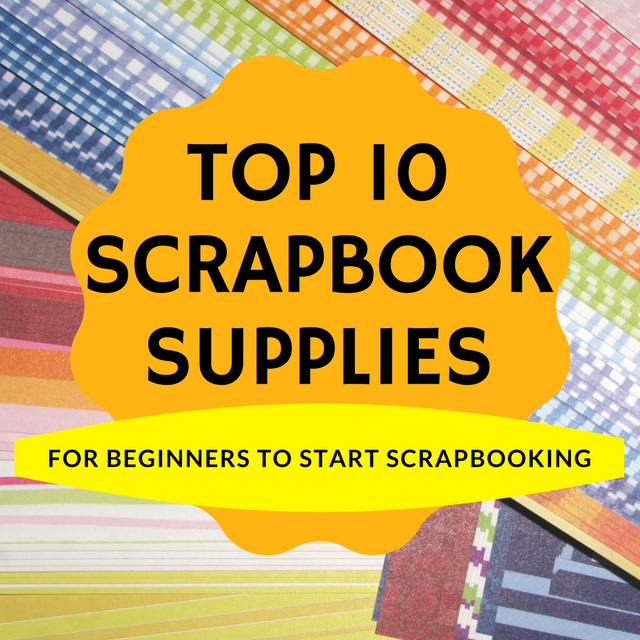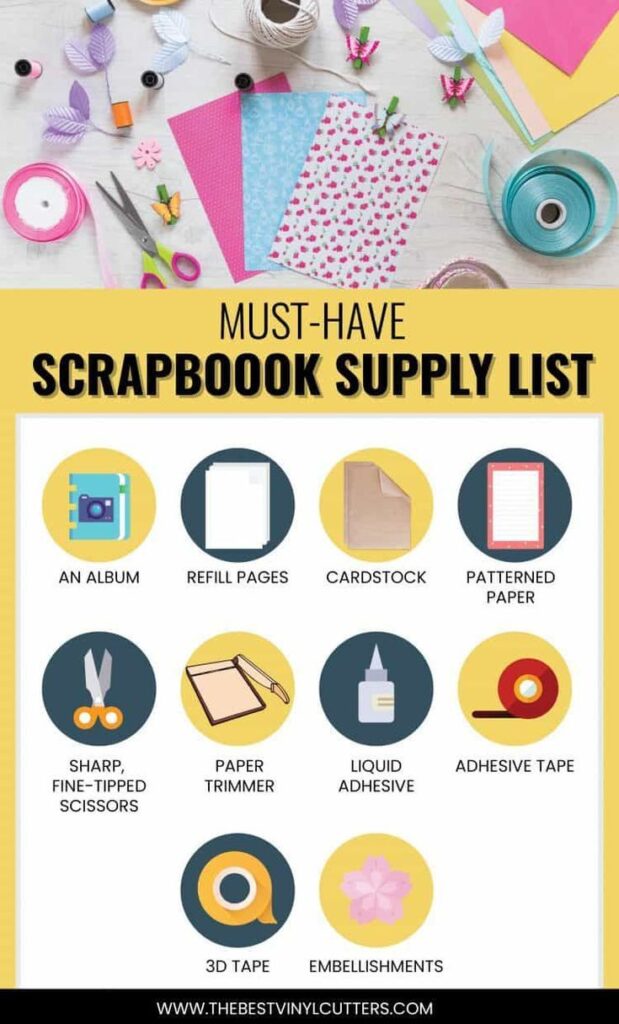If you’re new to the world of scrapbooking and feeling overwhelmed by all the tools and supplies available, fear not! “The Essential Toolkit for Scrapbook Beginners” is here to help. In this comprehensive guide, you’ll discover the must-have tools that will set you on the path to creating beautiful and meaningful scrapbook pages. From adhesive tape to cutting tools, we’ll explain how each tool plays a vital role in the scrapbooking process, making it easier for you to get started and unleash your creativity. Let’s dive in and explore the essential scrapbooking tools together!
The Essential Toolkit for Scrapbook Beginners

1. Paper Trimmer
1.1 Importance of a Paper Trimmer
A paper trimmer is an essential tool for any scrapbook beginner. It allows you to precisely cut your paper or cardstock to the desired size and shape, ensuring clean and straight edges. This is especially important when creating layouts or adding photos to your scrapbook. A paper trimmer eliminates the need for scissors and provides a more professional and polished look to your projects.
1.2 Types of Paper Trimmers
There are several types of paper trimmers available, each with its own advantages. Rotary trimmers, guillotine trimmers, and slide-style trimmers are commonly used in scrapbooking. Rotary trimmers have a circular blade that rolls along a track, providing smooth and accurate cuts. Guillotine trimmers have a blade that is lever-operated, making them ideal for cutting through thicker materials. Slide-style trimmers have a sliding blade that moves along a rail, allowing for precise trimming.
1.3 How to Use a Paper Trimmer Properly
To use a paper trimmer effectively, follow these steps:
- Place your paper or cardstock onto the cutting surface of the trimmer, ensuring it is held securely.
- Align the paper with the desired measurement guides on the trimmer.
- Hold the paper in place with one hand, while using the other hand to move the trimmer blade across the paper, making a clean and straight cut.
- Repeat the process for each side of the paper, if necessary.
- Always follow the safety guidelines provided by the manufacturer to prevent accidents or injuries.
2. Scissors
2.1 Different Types of Scissors for Scrapbooking
Scissors are another essential tool in the scrapbooking toolkit, and there are various types to choose from depending on your needs. Precision scissors with a pointed tip are great for intricate cutting and detailed work, such as cutting out shapes or trimming delicate embellishments. Non-stick scissors are perfect for cutting adhesive-backed materials without leaving sticky residue on the blades. Craft scissors with different edge patterns, such as scalloped or zigzag, can add a decorative touch to your scrapbook pages.
2.2 Choosing the Right Scissors for Your Projects
When choosing scissors for your scrapbooking projects, consider the following factors:
- Size: Select scissors that feel comfortable in your hand and are appropriate for the size of your hands and projects.
- Material: Look for scissors made from stainless steel, as they are durable and resistant to corrosion. Non-stick coatings are also beneficial for preventing sticky residue buildup.
- Blade Type: Decide on the desired blade type based on the specific cutting needs of your projects. A fine-pointed blade is useful for intricate work, while a serrated blade enhances the grip and reduces slipping.
- Ergonomics: Consider scissors with ergonomic handles that provide a comfortable grip, reducing strain on your hand during extended cutting sessions.
2.3 Maintenance and Care Tips for Scissors
To keep your scissors in optimal condition, follow these maintenance and care tips:
- Clean the blades after each use to remove any adhesive or debris that may affect their performance. Use warm water and mild soap, or a blade cleaner specifically designed for scissors.
- Dry the blades thoroughly to prevent rust or corrosion from forming.
- Store your scissors in a dry and safe place, away from moisture and direct sunlight.
- Regularly sharpen the blades if they become dull. You can use a sharpening stone or take them to a professional for sharpening.
3. Adhesive
3.1 Types of Adhesive for Scrapbooking
Adhesive is a vital component of scrapbooking as it allows you to securely attach photos, paper, and embellishments to your pages. There are various types of adhesive available, each suited for different purposes:
- Tape Runners: These are easy to use and provide a clean and precise application of adhesive. They are great for attaching paper and photos.
- Liquid Glue: Liquid glue allows for more versatility in adhesive placement and is perfect for adhering heavier embellishments or three-dimensional elements.
- Glue Dots: These small, round adhesive dots provide a strong bond and are ideal for attaching buttons, beads, or other small embellishments.
- Foam Tape: Foam tape adds dimension to your projects by lifting elements off the page. It is commonly used to attach photos or create layered effects.
3.2 Best Practices for Using Adhesive
When using adhesive in scrapbooking, keep the following best practices in mind:
- Apply adhesive sparingly to prevent excess glue from seeping out and staining your paper or photos.
- Always test the adhesive on a scrap piece of paper before applying it to your final artwork to ensure it does not damage or alter the paper.
- Use acid-free, archival-quality adhesive to ensure the longevity of your scrapbook pages.
- Store your adhesive in a cool, dry place to prevent it from drying out or becoming ineffective.
3.3 Adhesive Removal Techniques
If you need to remove or reposition an element that has been adhered with adhesive, try these techniques:
- Gently lift the edge of the element using a craft knife or tweezers. Apply a small amount of adhesive remover to loosen the adhesive bond and carefully remove the element.
- For tacky adhesive residue, use a rubber eraser to gently rub and lift it off the surface.
- If the adhesive has dried or hardened, use a heat tool, such as a hairdryer on a low setting, to soften it before attempting to remove it.
4. Cardstock
4.1 Importance of Cardstock in Scrapbooking
Cardstock is a thicker and more durable type of paper that is essential for creating sturdy pages and embellishments in scrapbooking. It provides a solid foundation for your designs and prevents your pages from becoming flimsy or easily damaged. Cardstock is available in a wide range of colors and finishes, making it versatile for different themes and designs.
4.2 Different Types and Thicknesses of Cardstock
Cardstock comes in various types and thicknesses, and the right choice depends on the specific project and design aesthetic you want to achieve. Some common types of cardstock include:
- Smooth Cardstock: This type has a smooth and even surface, ideal for printing or stamping images and text.
- Textured Cardstock: Textured cardstock adds visual interest and dimension to your projects. It can resemble a variety of textures, such as linen, canvas, or wood grain.
- Metallic Cardstock: Metallic cardstock has a shiny and reflective surface, adding a touch of elegance and glamour to your scrapbook pages.
- Patterned Cardstock: Patterned cardstock already includes decorative designs and patterns, adding visual interest to your pages without the need for additional embellishments.
The thickness of cardstock is measured in pounds or grams per square meter (gsm). The higher the number, the thicker and sturdier the cardstock. Choose a thickness suitable for your project’s needs, considering factors such as page weight, layering, and dimensional elements.
4.3 Tips for Choosing and Using Cardstock
When selecting and using cardstock for your scrapbooking projects, keep these tips in mind:
- Consider the color and finish of the cardstock in relation to your project’s theme and desired aesthetic.
- Test the cardstock with your chosen adhesive to ensure they bond well without causing damage or warping.
- Invest in a variety pack of cardstock to have a range of colors, finishes, and thicknesses available for your different projects.
- Store your cardstock in a cool and dry place to prevent it from fading or warping due to moisture or sunlight exposure.

5. Patterned Paper
5.1 Using Patterned Paper to Add Visual Interest
Patterned paper is a versatile and essential element in scrapbooking. It adds visual interest, color, and texture to your pages, making them visually appealing and engaging. Patterned paper comes in a wide variety of designs, themes, and patterns, allowing you to coordinate it with your project’s theme or tailor it to specific occasions or memories.
5.2 Coordinating Patterned Paper with Your Theme
When selecting patterned paper for your scrapbooking projects, consider the following tips:
- Match the colors of the patterned paper to your project’s theme or the colors in your photos to create a cohesive and harmonious design.
- Choose pattern designs that complement or enhance the theme of your photos or the story you want to tell.
- Incorporate a variety of scales and sizes of patterns to add visual interest and depth to your pages.
- Mix and match different patterns from the same collection or coordinate patterns from different collections to create unique and personalized designs.
5.3 Tips for Cutting and Storing Patterned Paper
To cut and store patterned paper effectively, follow these tips:
- Use a paper trimmer or scissors to cut the patterned paper into the desired size and shape for your project.
- Store your patterned paper in acid-free and lignin-free sleeves, folders, or storage boxes to protect it from yellowing or deteriorating over time.
- Label each patterned paper with the collection name, designer, and any specific details to make it easier to find and use in the future.
- Organize your patterned paper by color, theme, or collection to simplify the selection process for future projects.
6. Page Protectors
6.1 Purpose and Benefits of Page Protectors
Page protectors are clear, plastic sleeves that allow you to slide your completed scrapbook pages into them, protecting them from fingerprints, dust, and damage. Page protectors are especially useful for preserving your layouts and ensuring the longevity of your memories. They also provide an added layer of durability and strength to your pages, making them sturdier and less prone to tearing or bending.
6.2 Different Sizes and Formats of Page Protectors
Page protectors come in various sizes and formats to accommodate different scrapbook album sizes and page orientations. The most common page protector sizes are 12×12 inches, 8.5×11 inches, and 6×6 inches. These sizes typically fit the standard scrapbook album sizes available in the market. Page protectors can feature either top-loading or side-loading orientations, depending on your preference and ease of use.
6.3 Inserting and Protecting Your Scrapbook Pages
To insert your scrapbook pages into page protectors and ensure their protection, follow these steps:
- Slip your completed scrapbook page into the page protector, aligning it with the designated holes or edges.
- Smooth out any air bubbles or wrinkles in the page protector by gently pressing on it from the center towards the edges.
- Make sure your page is fully inserted and lies flat within the protector.
- Place the page protector into your scrapbook album, arranging them chronologically or according to your desired order.
- Avoid touching the inside of the page protector with bare hands to minimize the risk of fingerprints or smudges.

7. Journaling Pens
7.1 Importance of Journaling in Scrapbooking
Journaling is an integral part of scrapbooking as it helps capture memories, stories, and emotions associated with the photos and elements on your pages. Journaling pens allow you to add personal sentiments, captions, or descriptions to your layouts, enhancing the storytelling aspect of your scrapbook.
7.2 Different Types of Journaling Pens
There are various types of journaling pens available, each with different characteristics and uses:
- Acid-Free Pens: These pens are specifically designed for scrapbooking and are formulated to be archival-quality. They are resistant to fading, smudging, or bleeding, ensuring long-lasting and high-quality journaling.
- Waterproof Pens: Waterproof pens are suitable for journaling on photos or glossy paper, as they do not smudge or run when exposed to moisture.
- Colored Pens: Colored journaling pens allow you to add vibrant and visually appealing text to your layouts. They can match or complement the colors in your photos or the theme of your project.
7.3 Techniques for Writing and Lettering
To make your journaling visually appealing and engaging, consider these techniques:
- Practice various handwriting styles and lettering techniques to add personality and flair to your journaling.
- Experiment with different pen tip sizes to create variation in the thickness of your lines and calligraphy.
- Use different lettering styles, such as block letters, cursive, or decorative fonts, to highlight important words or titles.
- Incorporate doodles, borders, or small drawings around your journaling to add visual interest and creativity.
8. Die-cutting Machine
8.1 Introduction to Die-cutting Machines
Die-cutting machines are transformative tools in scrapbooking, allowing you to create intricate and precise shapes, patterns, and designs effortlessly. These machines work by using metal dies or electronic cut files to cut or emboss various materials, such as paper, cardstock, or fabric. Die-cutting machines provide endless creative possibilities and are a favorite among scrapbook enthusiasts.
8.2 Benefits of Using Die-cutting Machines
The benefits of using die-cutting machines in scrapbooking are:
- Efficiency: Die-cutting machines save time and effort by providing precise cuts and detailed designs in a fraction of the time it would take to cut by hand.
- Versatility: Die-cutting machines accommodate a wide variety of dies, allowing you to create intricate shapes, letters, borders, frames, and other decorative elements.
- Replicability: Die-cutting machines allow you to easily reproduce designs, ensuring consistency across your scrapbook layouts.
- Embossing and Stenciling: In addition to cutting, die-cutting machines can also emboss or stencil patterns onto your paper, adding texture and depth to your projects.
8.3 How to Choose the Right Die-cutting Machine
Consider the following factors when choosing a die-cutting machine:
- Manual or Electronic: Decide whether you prefer a manual machine that requires hand-cranking or an electronic machine that automates the cutting process.
- Compatibility: Ensure that the die-cutting machine you choose is compatible with the dies or electronic cut files you intend to use.
- Size: Consider the size of the machine and its cutting area to ensure it can accommodate the size of your scrapbook projects.
- Features and Accessories: Research the additional features, accessories, and compatible platforms or software that the machine may offer to enhance your die-cutting capabilities.

10. Embellishments
10.1 Enhancing Your Scrapbook with Embellishments
Embellishments are decorative elements that add visual interest, texture, and personality to your scrapbook pages. They can range from stickers, buttons, ribbons, brads, flowers, chipboards, to small trinkets or found objects. Embellishments play a crucial role in enhancing the overall aesthetic, theme, and storytelling of your scrapbook.
10.2 Types of Embellishments to Consider
There is an abundance of embellishments available to choose from, catering to various themes and design preferences. Some popular types of embellishments include:
- Stickers: Stickers are versatile and come in a wide range of designs, themes, and materials, making them an easy and convenient way to add decorations to your pages.
- Chipboard Elements: Chipboard elements are typically thicker pieces made from compressed paperboard. They come pre-cut in various shapes and designs and can be painted, inked, or covered in paper to match your projects.
- Ribbons and Trims: Ribbons and trims add texture and dimension to your pages, whether used as borders, bows, or wrapped around photos or elements.
- Buttons and Brads: Buttons and brads are small embellishments that can be attached to your pages, either for decorative purposes or as functional elements.
10.3 Placement and Adhesion Techniques
When placing and adhering embellishments, keep these techniques in mind:
- Consider the focal point of your layout and strategically place embellishments to draw attention and balance the overall design.
- Experiment with layering different embellishments to create dimension and depth in your pages.
- Use adhesive appropriate for the embellishment material and weight to ensure they adhere securely but without damaging the page.
- Consider using foam adhesive or pop dots to lift some embellishments off the page, adding a three-dimensional effect.
In conclusion, the essential toolkit for scrapbook beginners consists of tools and materials that are fundamental to the scrapbooking process. From paper trimmers and scissors for precise cutting, to adhesive and page protectors for secure attachment and preservation, each tool and material serves a specific purpose in enhancing your scrapbook pages. Additionally, journaling pens, die-cutting machines, and embellishments provide creative expression and personalization. By understanding the importance, types, and techniques associated with each tool and material, you can confidently embark on your scrapbooking journey and create beautiful and meaningful scrapbook projects.


